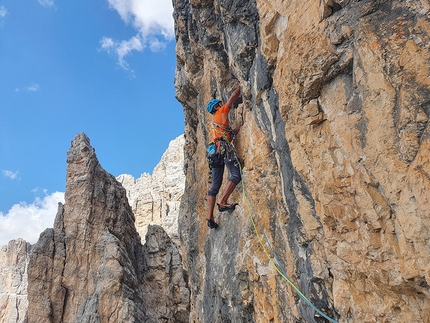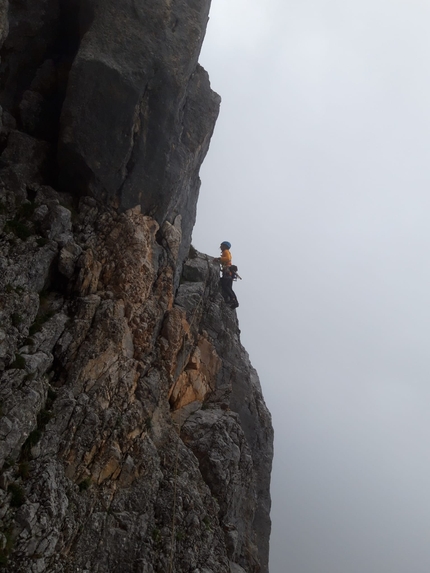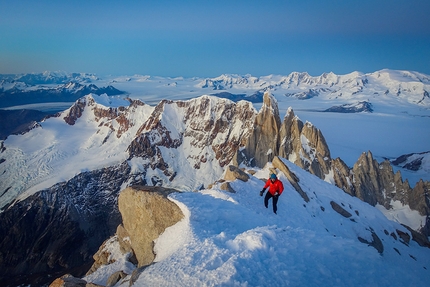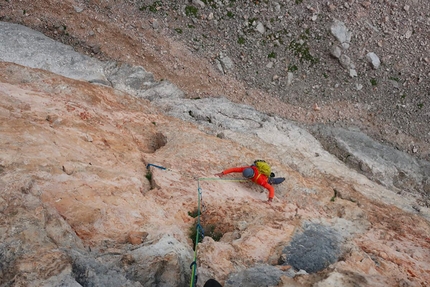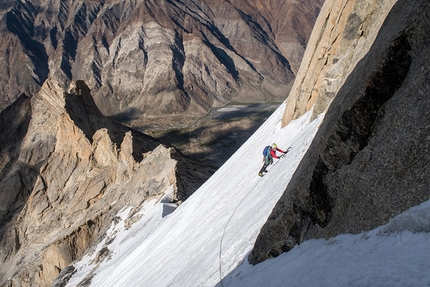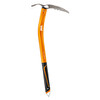Monviso NNW Ridge in winter, following in the footsteps of Patrick Berhault. By Barbara Vigl

 1 / 7
1 / 7 David Göttler
David Göttler
From the plains, on clear days the Stone King stands all alone on the horizon. Its soaring pyramidal shape is a joy to the eyes of those who love mountains. Important chapters of mountaineering history have been written along its edges, its ridges, its gullies. At its feet springs the most beautiful and majestic river that crosses northern Italy, the Po.
June 1968, fifty-four years ago, a distant past, the last century, abundant snowfall and new discoveries, politically controversial, free and at the same time imprisoned by a thousand novelties. It is against this background that Livio Patrile and Hervè Tranchero, two local mountaineers in love with Il Re, spent five days and four bivouacs completing out one of the most grandiose skyline traverses of the Alps: the long integral NNW Ridge that leads from Colle delle Traversette (2950m) to the summit of Monviso (3841m).
A quick glance at a photo of this route and one remains perplexed, amazed and delighted that such a beautiful skyline exists. Ascents and downclimbs, abseils and traverses… it’s a condensation of difficulty and endurance, an ambient for Alpinists with a capital A.
Time passes quickly as one season rapidly follows the next. Winter 2001. The French mountaineer Patrick Berhault, during his astonishing traverse of the Alps, on his one hundred and thirty-fifth day and after saying goodbye to his two friends who had accompanied him to the Traversette Pass, begins to climb up towards the sky.
There is plenty of snow, the cold bites. Two full, freezing and silent days later he completes, after the first solo carried out in only 8 hours by an extremely young Riki Maero in August 1990, the first winter solo… and in what a winter!
Berhault notes in his diary, "It feels like I’m in Cordillera Blanca or in the Himalayas." Numerous years have passed since then, and in the meantime a few romantics have climbed it, although it isn’t, and never will be, a "classic": fashions change and, sometimes wrongly, we look elsewhere. Even the King is changing… It’s now 2022, time has passed so quickly, and now it's Babsi's turn to tell us about her ascent. By Ivo Ferrari
MONVISO IN WINTER by Barbara Vigl
There's something extraordinary about inspiration - it's anchored in memory like an image, yet it can mutate imperceptibly over time: from something distant to something extremely tangible, from a dream to a real goal. For me, one thing will probably never change: the way Patrick Berhault's approach towards adventure and his solo of the NNW ridge of Monviso have remained etched in my memory: free, creative and different, in a beautiful manner.
Ten years after I first heard about his ascent, last winter I had the opportunity to follow in the footsteps of history. On the 3rd of March 2022, David Göttler and I set off at 4:30 in the morning from the Pian del Re parking lot. An exceptionally dry winter made it possible to climb over frozen snow slopes to Col de la Traversette, where the old tracks ended abruptly and a long-cherished dream could now begin.
The conditions were very good and we progressed rapidly over the first five summits (Rocce Fourioun, Aiguille Bleue, Punta Venise, Punta Udine and Punta Roma), climbing mostly dry rock with sections of firm snow in between. From there, the climb and the route-finding got more demanding; the ridge becomes more jagged, while spikey little rock towers require constant scrambling up and down, plus some rope maneuvers.
After climbing Punta Gastaldi and Punta Due Dita, we reached Passo Due Dita in the early afternoon, where we had planned our bivouac. It had been difficult to plan how far we would get on that first day, as we had failed to find anything about a winter climb except Berhault's ascent and an attempt carried out by a French party a few years ago. All we knew is that our progress would depend entirely on the conditions we'd encounter on the ridge.
The next morning clouds surprisingly enveloped our mountain for over an hour, and when they finally dissipated they left behing a fresh, slippery layer of snow. Temperatures had dropped significantly and we climbed the Visolotto's NW ridge and then traversed its three summits in gloves and with crampons.
The final and longest climb, the north face of Monviso, offers three alternatives. The easiest route is the Couloir Perotti, which usually has snow cover until early summer, but due to the lack of precipitation, we encountered only bare glacier ice. We decided to climb the Red Pillar instead, which required careful and concentrated climbing as fresh snow covered every hold. After that, progress became easier again and we reached the summit of Monviso at 4pm. Climbing down the normal route on the south face required a lot of attention once again, and we reached the end of the difficulties at 6 pm. From there, a path with some equipped sections leads to Rifugio Quintino Sella, where we spent the night.
Originally we had planned to continue the descent to the valley, but during the second day I somewhat surprisingly developed lung problems. This led to the collapse of my right lung on the way to the hut and caused serious breathing problems. Fortunately we had arranged to meet friends at the hut and we spent the night together in the winter shelter. I recovered well enough in the morning to descend with them.
Alpine climbs like Berhault's first winter ascent of the Monviso Traverse can never be copied, because mountains and those who climb them are constantly changing - that's why alpinism will probably never be comparable, and indeed, I don't think that's even necessary. I imagine that conditions were more difficult in the winter of 2001, but nevertheless during our ascent I believe I felt the magic that Berhault's words have always radiated within me.



 Copia link
Copia link






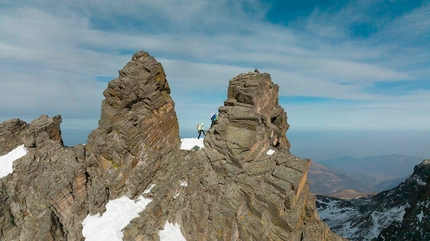
 See all photos
See all photos